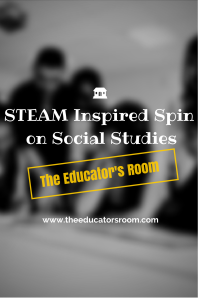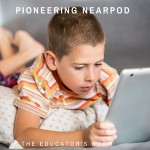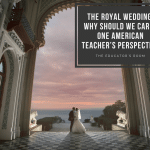 Science, Technology, Engineering, and Math – the STEM subjects joined forces with Art (Design) to become STEAM, the acronym which stands for education that deliberately promotes 21st-century transformations in thinking. Social studies skills are not included as a focus and I like to think it’s because it is at the root of the original STEM. As a social studies educator, I’m struggling to make that more apparent so I attended the November, Vermont State Technology Conference hosted by Vitalearn.org. The maker spaces and new tools were exciting and innovative but I wanted something that would not change how I teach or involve a large investment of time and money. I did not want the goals of STEAM to make obsolete the lessons of history. I found what I was looking for in an educator whose presentation offered pathways for Substitution, Augmentation, Modification, and Redefinition (the SAMR model). Since the conference, I spent days editing my favorite unit. How fun it will be to not set it aside but to make it relevant to the needs of this student body! Here is my thought process for designing improvements.
Science, Technology, Engineering, and Math – the STEM subjects joined forces with Art (Design) to become STEAM, the acronym which stands for education that deliberately promotes 21st-century transformations in thinking. Social studies skills are not included as a focus and I like to think it’s because it is at the root of the original STEM. As a social studies educator, I’m struggling to make that more apparent so I attended the November, Vermont State Technology Conference hosted by Vitalearn.org. The maker spaces and new tools were exciting and innovative but I wanted something that would not change how I teach or involve a large investment of time and money. I did not want the goals of STEAM to make obsolete the lessons of history. I found what I was looking for in an educator whose presentation offered pathways for Substitution, Augmentation, Modification, and Redefinition (the SAMR model). Since the conference, I spent days editing my favorite unit. How fun it will be to not set it aside but to make it relevant to the needs of this student body! Here is my thought process for designing improvements.
Substitutions and Modifications. Every year I teach a series of global history lessons on commodities that have made significant impacts over time. I start with 16th century European and Ming dynasty exploration. I present studies on the transfer of power. We focus on those in history who learn to manipulate capital goods and productivity rather than those who simply control a natural resource. Students use the daily lessons as models for their own exploratory research on a commodity or natural resources of their choice. They investigate a basic question- How does the use and design of a commodity change how people live? What was missing from my lesson was the opportunity for all students to actually manipulate and control a resource. What was also missing was that opportunity for each and every student to create something completely new of their own. Students were studying the history of change without actually being involved in change. While I have tried in the past, to incorporate activities that engage students with commodities such as chocolate or coffee or spice, my classroom does not have a workspace for this sort of productivity or the mess. Overall costs were expensive and food allergies were always a concern. Attending a maker space for creating LED Glowies sparked the notion of substituting our study of chocolate with the study of the history of light. To explore light as a commodity and to allow students to manipulate and control this resource could be a transformative learning experience, especially during these dark days of the winter solstice.
Redefinition. The presenter who inspired me, a Vermont Educator, Tricia Finkle was forthright about sharing her Google presentation with hopes that we would, in turn, share with others. Her slide show is geared towards 1st-grade educators and art teachers and a level of science I can quickly comprehend. Tricia presented lessons that: first, explain the properties of light and then how light is generated from a single coin battery and a LED. Only then does Tricia present how artists manipulate light in order to establish a perspective or point of focus? A variety of model light projects made from recycled goods made me realize why I liked this veteran teacher. From her presentation, I am able to explain exactly what I learned and why I learned it. I was able to know why I would make the art piece I hoped to make. To be similarly purposeful I would need to be deliberate in the presentation of the overlying question- how does the use and design of light change how people live? I need to think about how students will individually relate to the idea of light as a metaphor. Could they design art that sheds light on a global issue? Could awareness of non-profits, charities, and peoples in need be brought to light? This is a time of year where light is used symbolically to enlighten thinkers and ignite community spirits.
Augmentation. One reason for avoiding changes to any lesson is that it quickly becomes too much work for one individual. I presented my ideas and draft unit to other educators. Right away the tech integrationist offered to make the bulk purchase of LED lights (3 pack of red, blue, white lights) and 3-volt coin batteries for less than 1$ per student. His enthusiasm and experience mean that individuals who want to continue to develop studies of light technologies can with his tutelage. An earth science teacher noted that he would be teaching a unit on the solar system simultaneously. We discussed the possibility of swapping classrooms, teaching each other’s lessons and or having his students take the idea of light in a different direction. Spectography and the natural resources used to create these cheap batteries and bulbs are just a few of the topics to explore.
If I change this unit it must have real-world implications. We know students have ideas worth listening to and using this project to literally “shed light” on an issue or interest can not end with the creation alone, it must be shared with a real audience. While I hope to introduce students to auras, hashtags, QR codes as means of transmitting links to actual non-profits, charities, communities or individuals it is their responsibility to reach larger audiences. The world is alive with Festivals of Light in local towns and large cities, in cathedrals and Hindu temples. As an example, New York City’s Festival of Light is such a grandiose level. There is a world of possibility and so I hope to not only post on our progress and our designs but to also garner ideas from readers. How would you implement such change in your classroom?
I would be remiss if I did not give credit to Tricia Finkle (scifair@norwich.edu) and the resources that she shared.
How to make Glowies https://docs.google.com/document/d/14nazHUOgTEz7PRNWhsbkxRsfGMxbrwsr8T8gouaZWj4/edit
Wildcat Inventors Workshop http://vssmf.pbworks.com/w/page/84655660/Wildcat%20Inventors%20Workshop
Next Generation Science Standards




